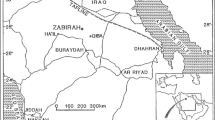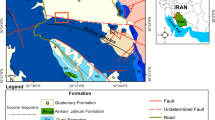Abstract
Ground penetrating radar (GPR) method is used as a tool to identify the zonation boundaries in ignimbrite series through their columnar section. Ignimbrites can be classified in terms of welding degree, colour, texture and mineralogical compositions. The research area comprises a part of İncesu (Kayseri) ignimbrite at Central Anatolia, Turkey. This ignimbrite is divided into three levels and each level has clear differences in terms of macroscopic and microscopic views. This paper presents the results of an application of GPR for the determination of zonation boundary within the ignimbrite flow unit in the view of their textural and petrological features. RAMAC CU II equipment was used with 250 MHz shielded antenna on parallel ten profiles to observe the physical difference among the ignimbrite levels of the study area. Two levels out of three have been defined at the İncesu ignimbrite and supported by field geology and petrographical studies. The first level, which is extremely fractured structure, is about 1.5 m thick and matches with middle level of the İncesu ignimbrite. The second level has an average 50–75 cm thickness and matches with lower level of the ignimbrite. In this manner, vertical lithological variations should be taken into consideration during petrological investigation of the ignimbrites.









Similar content being viewed by others
References
Aldas GU, Kadıoglu S, Ulugergerli E (2006) The usage of ground penetrating radar (gpr) in designing blast pattern. Rock Mech Rock Eng 39:281–290
Aydar E, Gourgaud A (1998) The geology of Mount Hasan stratovolcano, Central Anatolia, Turkey. J Volcanol Geotherm Res 85:129–152
Benson AK (1995) Applications of ground penetrating radar in assessing some geological hazards: examples of groundwater contaminants, faults, cavities. J Appl Geophys 33:177–193
Bozkurt E (2001) Neotectonics of Turkey—a synthesis. Geodinamica Acta 14:3–30
Cagnoli B, Ulrych TJ (2001) Ground penetrating radar images of unexposed climbing dune-forms in the Ubehebe hydrovolcanic field (Death Valley, California). J Volcanol Geotherm Res 109:279–298
Cas RAF, Wright JV (1988) Volcanic succession modern and ancient. Unwin Hyman, London pp 528
Cezar GS, Rocha PLF, Buarque A, Costa A (2001) Two Brezilian archeological sites investigated by GPR: Serrano and Morro Grande. J Appl Geophys 47:227–240
Daniels JJ (1989) Fundamentals of ground penetrating radar. Proceedings of SAGEEP. Golden Colorado
Davis JL, Annan AP (1989) Ground-penetrating radar for high-resolution mapping of soil and rock stratigraphy. Geophys Prospect 37:531–551
Druitt TH (1998) Pyroclastic density currents. In: JS Guilbert, RSJ Sparks (eds) The physics of explosive volcanic eruptions. J Geol Soc Lond 145:145–182
Gómez-Ortiz D, Martín-Velázquez S, Martín-Crespo T, Márquez A, Lillo J, López I, Carreño F (2006) Characterization of volcanic materials using ground penetrating radar: a case study at Teide volcano (Canary Islands, Spain). J Appl Geophys 59:63–78
Grasmueck M, Weger R, Horstmeyer H (2005) Full-resolution 3D GPR imaging. Geophysics 70:12–19
Green A, Gross R, Holliger K, Horstmeyer H, Baldwin J (2003) Results of 3-D georadar surveying and trenching the San Andreas fault near its northern landward limit. Tectonophysics 368:7–23
Innocenti F, Mazzuoli R, Pasquare G, Redicati de BF, Villari L (1975) The Neogene calc-alkaline volcanism of Central Anatolia: geochronological data of Kayseri–Nigde area. Geol Mag 112:349–360
Kadioglu S, Daniels JJ (2002) A hybrid 2d/3d ground penetrating radar (gpr) survey of brownfield site along Lake Street in Chicago, Illinois (USA). In: International conference on Earth sciences and electronics 2002 (ICESE-2002), vol 2, pp 255–261
Kadioglu S, Daniels JJ (2004) Integrated 3D visualization of GPR data and EM-61 data. Geochim Cosmochim Acta 68(11):A468
Kadıoğlu S, Ulugergerli EU (2004) Determination of cavities using ground penetrating radar in Dalaman-Akköprü dam construction Area. The sixteenth international geophysics congress and exhibition of Turkey, Abstract book 372–375
Kim C, Daniels JJ, Guy E, Radzevicius SJ, Holt J (2000) Residual hydrocarbons in a water-saturated medium: a detection strategy using ground penetrating radar. Environ Geosci 7(4):169–176
Koralay T, Kadioglu YK (2003) Petrographic determination of top and botoom levels of ignimbrites: İncesu (Kayseri) ignimbrite. J Fac Eng Arch Selcuk Univ 18:43–54
Kürkcüoglu B, Sen E, Aydar E, Gourgaud A, Gündoğdu N (1998) Geochemical approach to magmatic evolution of Mt. Erciyes stratovolcano Central Anatolia, Turkey. J Volcanol Geotherm Res 85:473–494
Le Pennec JL, Bourdier JL, Froger JL, Temel A, Camus G, Gourgaud A (1994) Neogene ignimbrites of the Nevsehir plateau (Central Turkey): stratigraphy, distribution and source constraints. J Volcanol Geotherm Res 63:59–87
Le Pennec JL, Temel A, Froger JL, Sen S, Gourgaud A, Bourdier JL (2005) Stratigraphy and age of the Cappadocia ignimbrites, Turkey reconciling field constraints with paleontologic, radiochronologic, geochemical and paleomagnetic data. J Volcanol Geotherm Res 141:45–64
Leucci G, Negri S (2006) Use of ground penetrating radar to map subsurface archaeological features in an urban area. J Archaeol Sci 33:502–512
Lunt IA, Hubbard SS, Rubin Y (2005) Soil moisture content estimation using ground-penetrating radar reflection data. J Hydrol 307:254–269
Miyamoto H, Haruyama J, Rokugawa S, Onishi K, Toshioka T, Koshinuma J (2003) Acquisition of ground penetrating radar data to detect lava tubes: preliminary results on the Komoriana cave at Ruji volcano in Japan. Bull Eng Geol Env 62:281–288
Notsu K, Fujitani T, Ui T, Matsuda J, Ercan T (1995) Geochemical features of collision-related volcanic rocks in central and eastern Anatolia, Turkey. J Volcanol Geotherm Res 64:171–192
Orlando L (2002) Ground penetrating radar in massive rock: a case history. Eur J Environ Eng Geophys 7:265–279
Pasquare G, (1968) Geology of the Cenozoic volcanic area of Central Anatolia. Atti Accad Naz Lincei Mem 9:55–204
Pasquare G, Poli S, Vezzoli L, Zanchi A (1988) Continental arc volcanism and tectonic setting in Central Anatolia, Turkey. Tectonophysics 146:217–230
Porsani JL, Sauck WA, Junior AOS (2006) GPR for mapping fractures and as a guide for the extraction of oranamental granite from a quarry. A case study from southern Brazil. J Appl Geophys 58:177–187
Russell JK, Stasiuk MV (1997) Characterization of volcanic deposits with ground penetrating radar. Bull Volcanol 58:515–527
Rust AC, Russell JK (2000) Detection of welding in pyroclastic flows with ground penetrating radar: insights from field and forward modelling data. J Volcanol Geotherm Res 95:23–34
Sambuelli L, Socco LV, Brecciaroli L (1999) Acquisition and processing of electric, magnetic and GPR data on a Roman site (Victimulae, Salussola, Biella). J Appl Geophys 41:189–204
Schumacher R, Keller J, Bayhan H (1990) Depositional characteristics of ignimbrites in Cappadocia, Central Anatolia, Turkey. In: Savaşçın MY, Eronat AH (eds) Proceedings of the international Earth science congress on Aegean regions (IESCA 1990), vol 2, pp 435–449
Schumacher UM, Schumacher R, Götte-Viereck GL, Lepetit P (2004) Areal distribution and bulk rock density variations of the welded incesu ignimbrite, Central Anatolia, Turkey. Turk J Earth Sci 13:249–267
Sen E, Kürkcüoğlu B, Aydar E, Gourgaud A, Vincent PM (2003) Volcanological evolution of Mount Erciyes stratovolcano and origin of the Valibaba Tepe ignimbrite (Central Anatolia, Turkey). J Volcanol Geotherm Res 125:225–246
Seol SJ, Kim JH, Song Y, Chung SH (2001) Finding the strike direction of fractures using GPR. Geophys Prospect 49:300–308
Sparks RSJ, Wilson L (1976) A model for the formation of ignimbrites by gravitational column collapse. J Geol Soc Lond 132:441–451
Temel A, Gündoğdu MN, Gourgaud A, Le Pennec JL (1998) Ignimbrites of Cappadocia (Central Anatolia, Turkey): petrology and geochemistry. J Volcanol Geotherm Res 85:447–471
Toprak V (1998) Vent distribution and its relation to regional tectonics, Cappadocian Volvanics, Turkey. J Volcanol Geotherm Res 85:55–67
Acknowledgments
This study was financially supported by DPT 2003-K-120-190-4-1 and Scientific Research Projects Unit of the Ankara University under grant nos. 2003-07-45-015 and 2005-07-45-027. The authors would also like to extend their thanks to unknown reviewers of the manuscript for their valuable contributions.
Author information
Authors and Affiliations
Corresponding author
Rights and permissions
About this article
Cite this article
Koralay, T., Kadioglu, S. & Kadioglu, Y.K. A new approximation in determination of zonation boundaries of ignimbrite by ground penetrating radar: Kayseri, Central Anatolia, Turkey. Environ Geol 52, 1387–1397 (2007). https://doi.org/10.1007/s00254-006-0581-x
Received:
Accepted:
Published:
Issue Date:
DOI: https://doi.org/10.1007/s00254-006-0581-x




